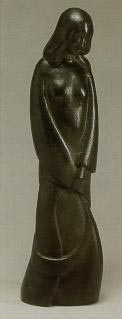Harold C. Swartz
1889-1948
Harold Swartz was born in San Marcial, New Mexico in 1887. He studied
in Paris, Rome, and Berlin.
Swartz graduated from Ohio State University and then worked as a commercial
artist in Cleveland. Swartz worked in advertising for about fifteen
years. During World War I, he served in the Army and worked as an editor
for the G.I. newspaper.
Swartz attempted painting, but received little positive feedback and
ultimately became discouraged. In 1920 his friend the Italian sculptor
Romanelli introduced him to sculpture and consequently a promising art
career. He sculpted in his spare time while working as an officer for
the Cleveland Trust Company. He soon quit his lucrative job to devote
himself to his art.
Financed by a wealthy patron, Swartz traveled abroad to study and develop
his talents. He lived nine months in Germany, where he attended the
Kunstgewebschule with Bruno Paul and George Kolbe. He studied architecture
and monumental sculpture. Swartz exhibited a stone sculpture and won
second prize. He completed his degree and was given the honorary title
of Herr Professor by the German State. Swartz also spent time studying
in Paris and Rome. He eventually returned to Los Angeles where he lived
since 1919. Swartz was an instructor at the Otis Art Institute and at
the University of Southern California. He was also an instructor at
Chouinard Art Institute in Los Angeles. Swartz was Commissioner of Art
for the City of Los Angeles for five years.
Swartz was married to Winifred Dunn, a successful writer of some thirty-four
movie scripts and well-recognized art critic. Eventually they divorced.
Swartz remarried and had three children with his second wife.
Swartz exhibited extensively beginning in the early 1920s. He participated
in all the major fine art exhibitions in Southern California and won
many prizes. He was a member of the Sculptors Guild of Southern California
and the California Art Club. Swartz had a solo exhibition at the Los
Angeles County Museum of Art in 1923. He exhibited at the Art Institute
of Chicago in 1925 and 1929.
In 1922 after the huge success of the first annual exhibition of the
Sculptors Guild, Swartz led a movement to build a fine art bronze foundry.
It is unknown if this project was successful, but some of his bronzes
have a foundry mark from a Los Angeles location.
Swartz designed several fountains for Hollywood celebrities, mostnotably
Mary Pickford and Douglas Fairbanks. Large bronze sculptures were the
centerpieces of these fountains.
Swartz, like many artists in Los Angeles, did work for movie studios,
including MGM. In many newspaper articles published around the end of
World War II, Swartz is credited with the creation of the Oscar. This
is disputed by all other historical sources. However, Swartz’s
student George Stanley is officially credited with the design of the
Oscar. Nonetheless, the style and technique of the Oscar is very similar
to many of Swartz’s sculptures. His work “Dans Macabre”
resembles the “Oscar.” This work was exhibited at the Art
Institute of Chicago in 1929 and a facsimile appears in a 1931 film
called “Scandal Sheet.”
During World War II Swartz, worked as a civilian employee at Morrison
Field in Florida. He created a series of workshops for servicemen. These
“Hobby Shops” became very popular at bases from Florida
to Brazil. Swartz received national recognition for this effort. He
also designed a four by four foot relief for the officers’ club
at Morrison Field.
Swartz was purely a modernist. He abstracted his subjects, employing
cubist elements that were mildly surreal and often allegorical. Swartz’s
works were received with great critical acclaim. He was also successful
at executing realistic busts of well-known public figures, including
Von Kliensmid, the president of the University of Southern California.
He won a commission to create a bust of Theodore Roosevelt, which was
located a local high school. Swartz also executed “Tommy Trojan,”
a monumental sculpture of a Trojan warrior on the University of Southern
California campus.
Swartz also became a fine printmaker. His etchings and lithographs show
the same modern sensibility as his sculpture.
|

